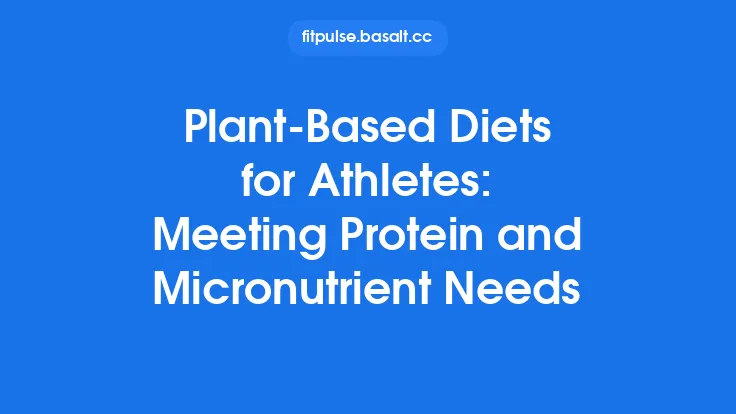Plant‑based post‑workout nutrition has come a long way, and today athletes and fitness enthusiasts have a wealth of options that deliver the full complement of essential amino acids without relying on animal products. While many people assume that only animal proteins are “complete,” a variety of plant foods either contain all nine essential amino acids on their own or can be combined to achieve a complete profile. Understanding the science behind protein quality, how to maximize digestibility, and which foods pair best together empowers you to rebuild muscle, support recovery, and stay energized after every training session.
What Makes a Protein “Complete”?
A protein is considered complete when it supplies adequate amounts of all nine essential amino acids (EAAs) that the human body cannot synthesize. The quality of a protein source is often expressed using two standardized metrics:
- PDCAAS (Protein Digestibility‑Corrected Amino Acid Score) – This score compares the amino acid profile of a food to human requirements and adjusts for digestibility. A score of 1.0 indicates a protein that meets or exceeds the reference pattern.
- DIAAS (Digestible Indispensable Amino Acid Score) – A newer method that evaluates the digestibility of each individual amino acid at the end of the small intestine, providing a more precise picture of how much of each EAA actually becomes available.
Most animal proteins (e.g., whey, egg, meat) score 1.0 on both scales. Among plant proteins, a handful achieve comparable scores, while many others fall short in one or more EAAs—most commonly lysine or methionine. Knowing which amino acids are limiting in a given food helps you pair it with complementary sources to create a balanced post‑workout meal.
Naturally Complete Plant Proteins
| Food | PDCAAS | DIAAS* | Limiting Amino Acid(s) | Typical Serving (g) | Approx. Protein (g) |
|---|---|---|---|---|---|
| Soybeans (edamame, tofu, tempeh) | 1.0 | 0.96 | None | 100 | 12–15 |
| Quinoa | 0.87 | 0.84 | None | 185 (cooked) | 8 |
| Hemp seeds | 0.66 | 0.71 | None (slightly low in lysine) | 30 | 10 |
| Chia seeds | 0.71 | 0.73 | None (slightly low in leucine) | 30 | 5 |
| Buckwheat | 0.78 | 0.80 | None | 100 (cooked) | 5 |
| Spirulina (dry) | 0.73 | 0.78 | None (low in methionine) | 7 | 4 |
\*DIAAS values are based on recent literature; exact numbers can vary by source.
These foods can be consumed alone or incorporated into recipes that provide the protein needed for muscle repair. For many athletes, a single serving of soy‑based products (e.g., 150 g of tempeh) delivers 20–25 g of high‑quality protein, which aligns well with typical post‑exercise protein targets.
Complementary Plant Protein Pairings
When a single plant food is not completely balanced, pairing it with another can fill the gaps. Classic combinations include:
- Legumes + Grains – Beans (low in methionine, high in lysine) paired with rice, wheat, or corn (high in methionine, low in lysine) create a complete amino acid profile.
- Nuts/Seeds + Legumes – Peanut butter on whole‑grain toast, or a lentil salad topped with pumpkin seeds, supplies both lysine and methionine.
- Cereals + Pseudocereals – Oats mixed with quinoa or amaranth boosts overall protein quality.
The key is to consume the complementary foods within the same meal or snack, ensuring that the amino acids are available simultaneously for muscle protein synthesis.
Enhancing Digestibility and Bioavailability
Plant proteins can be encumbered by anti‑nutrients such as phytates, tannins, and protease inhibitors, which reduce absorption. Simple culinary techniques can mitigate these effects:
- Soaking and Sprouting – Soaking beans, lentils, and grains for 8–12 hours, followed by a short sprouting period (1–3 days), activates endogenous enzymes that break down phytates and increase the availability of minerals and amino acids.
- Fermentation – Products like tempeh, miso, and sourdough bread undergo microbial fermentation, which degrades anti‑nutrients and pre‑digests proteins, making them easier on the gut.
- Cooking – Proper heat treatment denatures protein structures, exposing peptide bonds to digestive enzymes. However, over‑cooking can reduce certain heat‑sensitive amino acids (e.g., lysine), so aim for just‑right tenderness.
- Acidic Marinades – Marinating legumes or tofu in lemon juice or vinegar for 30 minutes can improve texture and aid in protein breakdown.
Incorporating these steps into your meal prep routine not only boosts protein quality but also supports overall nutrient absorption, which is crucial after a taxing workout.
Practical Portion Guidance for Plant‑Based Post‑Workout Meals
While the exact protein requirement varies by body weight, training intensity, and goals, a practical rule of thumb for most active adults is to aim for 20–30 g of high‑quality protein within 30–60 minutes after exercise. Below are sample portion calculations using complete or complementary plant proteins:
| Food Combination | Approx. Protein (g) | Typical Portion |
|---|---|---|
| 150 g tempeh (cooked) + ½ cup quinoa | 24 | 150 g tempeh + 92 g dry quinoa |
| 1 cup cooked lentils + ½ cup brown rice + 2 Tbsp pumpkin seeds | 22 | 198 g lentils + 98 g rice + 20 g seeds |
| 1 scoop (30 g) pea‑protein isolate + 1 Tbsp hemp seeds + 1 cup almond milk | 25 | 30 g isolate + 10 g seeds + 240 ml milk |
| ¾ cup Greek‑style soy yogurt + ¼ cup chia seeds + ½ cup mixed berries | 21 | 180 g yogurt + 30 g seeds + 75 g berries |
These examples illustrate that a balanced plant‑based post‑workout meal can be assembled with everyday pantry staples, without the need for exotic supplements.
Recipe Collection: Complete‑Protein Post‑Workout Meals
Below are five nutrient‑dense recipes that deliver 20–30 g of complete protein, incorporate complementary foods, and are easy to prepare in advance.
1. Savory Tempeh‑Quinoa Power Bowl
Ingredients (serves 1)
- 150 g tempeh, cubed
- ½ cup (dry) quinoa
- 1 cup broccoli florets, steamed
- ¼ cup edamame, shelled
- 2 Tbsp tahini
- 1 Tbsp soy sauce (low‑sodium)
- 1 tsp smoked paprika
- 1 tsp olive oil
- Fresh lemon zest, to taste
Method
- Rinse quinoa, combine with 1 cup water in a saucepan; bring to boil, reduce heat, cover, simmer 15 min. Fluff with fork.
- Toss tempeh cubes with soy sauce, smoked paprika, and olive oil. Pan‑sear over medium‑high heat 5–7 min until golden.
- Assemble bowl: quinoa base, tempeh, broccoli, edamame. Drizzle tahini, sprinkle lemon zest, and enjoy.
Protein: ~24 g (tempeh 15 g, quinoa 4 g, edamame 5 g)
2. Chocolate Hemp‑Pea Protein Smoothie
Ingredients (serves 1)
- 1 scoop (30 g) pea‑protein isolate (unflavored)
- 2 Tbsp hemp seeds
- 1 banana, frozen
- 1 Tbsp cocoa powder (unsweetened)
- 1 cup unsweetened almond milk
- ½ tsp cinnamon
- Optional: ½ tsp stevia or maple syrup
Method
- Blend all ingredients on high until smooth.
- Pour into a shaker bottle for on‑the‑go consumption.
Protein: ~27 g (pea isolate 20 g, hemp seeds 7 g)
3. Lentil‑Rice & Pumpkin Seed Salad
Ingredients (serves 2)
- 1 cup cooked green lentils
- ½ cup cooked brown rice
- ¼ cup roasted pumpkin seeds
- 1 small red bell pepper, diced
- 2 Tbsp chopped fresh parsley
- 1 Tbsp apple cider vinegar
- 1 tsp Dijon mustard
- 1 tsp olive oil
- Salt & pepper to taste
Method
- In a large bowl, combine lentils, rice, bell pepper, and parsley.
- Whisk together vinegar, mustard, olive oil, salt, and pepper; toss with salad.
- Sprinkle pumpkin seeds on top just before serving for crunch.
Protein: ~22 g (lentils 12 g, rice 3 g, pumpkin seeds 7 g)
4. Spirulina‑Infused Overnight Oats
Ingredients (serves 1)
- ½ cup rolled oats
- ¾ cup soy milk (or other high‑protein plant milk)
- 1 Tbsp chia seeds
- 1 tsp spirulina powder
- 1 Tbsp almond butter
- ½ cup sliced strawberries
Method
- In a mason jar, combine oats, soy milk, chia seeds, spirulina, and almond butter. Stir well.
- Seal and refrigerate overnight.
- In the morning, top with strawberries and enjoy cold or warmed.
Protein: ~21 g (oats 5 g, soy milk 7 g, chia 2 g, spirulina 4 g, almond butter 3 g)
5. Thai‑Style Chickpea & Quinoa Wrap
Ingredients (serves 1)
- ½ cup cooked quinoa
- ¾ cup canned chickpeas, rinsed and drained
- 1 Tbsp lime juice
- 1 tsp coconut aminos
- ½ tsp ground cumin
- 1 leaf large collard green (or whole‑grain tortilla)
- ¼ avocado, sliced
- 2 Tbsp shredded carrots
- Handful fresh cilantro
Method
- In a bowl, mash chickpeas lightly; add lime juice, coconut aminos, and cumin.
- Mix in quinoa and carrots.
- Place mixture on collard leaf, top with avocado and cilantro, roll tightly, and eat.
Protein: ~20 g (quinoa 4 g, chickpeas 10 g, collard leaf negligible, avocado 2 g, plus trace from spices)
Meal‑Prep Tips for Consistency
- Batch‑Cook Grains and Legumes – Cook a large pot of quinoa, brown rice, and lentils at the start of the week. Store in airtight containers; they keep 4–5 days in the fridge.
- Pre‑Portion Protein Powders – Use single‑serve sachets of pea or soy protein to streamline smoothie preparation.
- Freeze Ready‑to‑Heat Meals – Soups, stews, and bowls (e.g., tempeh‑quinoa) freeze well. Reheat in the microwave or stovetop, adding a splash of plant milk for creaminess if desired.
- Label with Protein Content – Write the total protein grams on each container. This visual cue helps you meet your post‑workout target without guessing.
Frequently Asked Questions
Q: Do I need to consume a “complete” protein every time?
A: Not necessarily. As long as you eat a variety of plant proteins throughout the day, your body can pool the amino acids to meet its needs. However, having a complete protein or a well‑balanced combination immediately after training can accelerate muscle protein synthesis.
Q: Are plant‑based protein powders as effective as whey?
A: High‑quality isolates (e.g., pea, soy, rice) have PDCAAS scores close to 1.0 and are rapidly digested, making them comparable to whey for post‑exercise recovery when consumed in adequate amounts.
Q: How do anti‑nutrients affect post‑workout recovery?
A: They can modestly reduce mineral absorption (e.g., iron, zinc) but have limited impact on the amino acids themselves. Using soaking, sprouting, or fermentation minimizes any negative effect, ensuring you get the most out of your protein sources.
Q: Can I rely solely on nuts and seeds?
A: Nuts and seeds are excellent for healthy fats and some protein, but they are typically low in lysine. Pairing them with legumes or grains (e.g., peanut butter on whole‑grain toast) creates a more complete amino acid profile.
Bottom Line
Plant‑based athletes have a robust toolkit for post‑workout recovery. By selecting naturally complete proteins like soy, quinoa, hemp, and spirulina—or by strategically pairing complementary foods such as legumes with grains—you can meet the essential amino acid requirements needed for muscle repair and growth. Enhancing digestibility through simple culinary techniques, planning portion sizes, and incorporating the recipes above will keep your recovery meals both nutritious and delicious, day after day. Embrace the diversity of plant proteins, and let your meals work as hard as your training.





